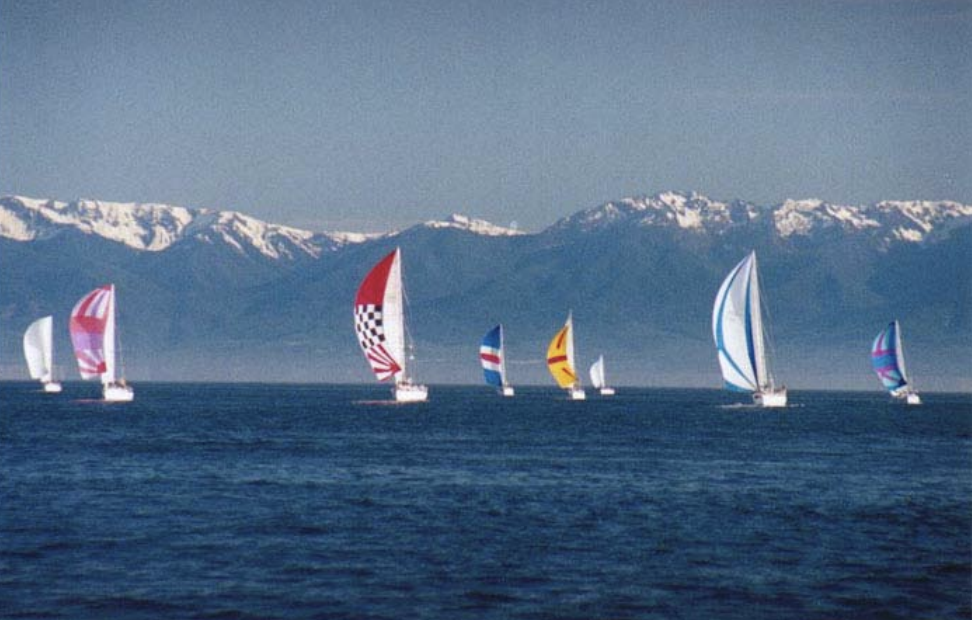
The Cheekee Monkee entered the millennium edition of the Cadillac Van Isle 360 late in the year in 1999. I believe that we were one of the first to register. At that time, we had no idea what to expect from the race, no crew lined up and no idea of where to get them. Last year Redshift and Sauterelle, both F-9A’s did the race and reportedly loved it.
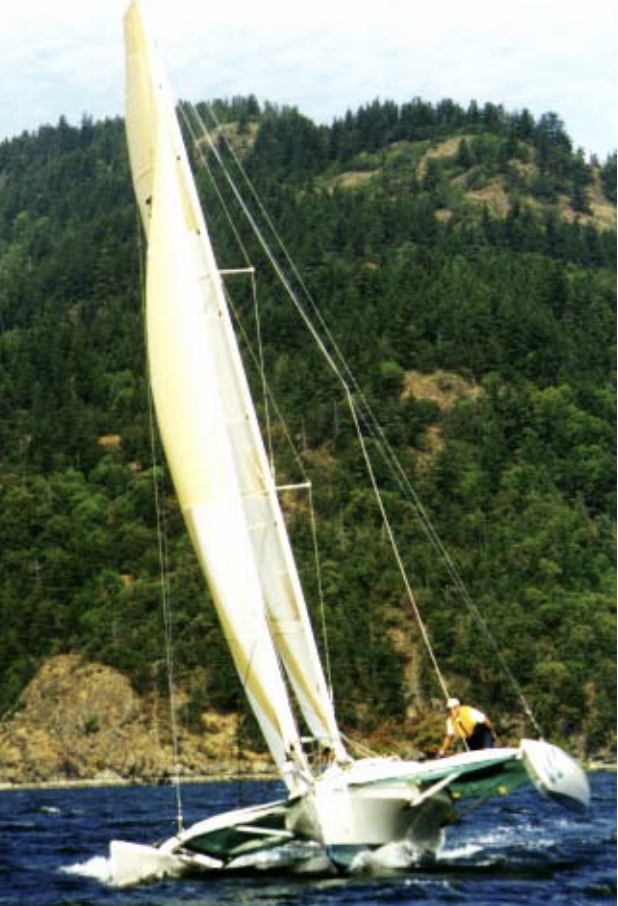
I have always wanted to sail around Vancouver Island and this race provided the motivation and the venue to get the dream accomplished. My first job was to find a willing and able crew for this regatta. I had been looking for crew for the whole season and had given my self a deadline on March 1st to find two sailors for our millennium campaign. It seemed too
much to expect anyone to find the time off we needed for the year 2000 racing season so back to last years plan, finding crew on a regatta-by-regatta basis. I sent out a request for crew for the Van Isle 360 on the F Boat list server. Lots of responses, I was able to select two crew persons to race around the island with me. One from Sydney Australia, reportedly
with Sidney Hobart experience. He is currently crewing on an F-31 in Sydney. The other from Southern California, who was an F-27 boat owner at the time and since the race has moved up to the new F-31 Cruiser Model. Now that I had my crew lined up, I started the outfitting work. New charts, a new jib, a new spinnaker, most important of all, a new propane heater for the comfort of the crew aboard the Cheekee Monkee.
Nanaimo – June 2
Friday, the day before the race, it’s practice day, our crew is together for the first time. After a provisioning trip to the local grocery store for fresh items and foodstuffs that I was not allowed to bring into Canada from the USA, we went down to the boat for our familiarization sail.
First the crew checked everything out below decks, and then they checked everything out above decks. All looked good and we bent on the sails. A fresh north westerly was blowing, just like the day before. We set sail in front of the pier where all the Van Isle boats were moored and popped the new chute. (A little showing off, psych out the competition, etc.) Our brand new custom chute looked fantastic, 10 minutes later we are charging out of the harbor at 10 – 12 knots. We heat it up to clear the point, the spinnaker luffs and then fills with a mighty cracccck and it’s gone, completely gone, the new spinnaker came unglued on all the seams. Panels were flying everywhere, multi-colored confetti, fluttering from the edges of the spinnaker. This was not a good omen for things to come. Quickly we retrieved the remnants of the chute and stowed it below. Not to be daunted, we set the screecher and planed out of the harbor at high speed and competed our practice session without the new spinnaker.
Back at the dock, apparently everyone had been watching us sail out and witnessed the spinnaker blow out. Of course everyone is a smart alec. When we returned it was to rejoiners of “Whose your sail maker?” “What did they use?, water soluble tape?” “Beautiful sail, can you get reusable ones?”
Fortunately that wasn’t our only spinnaker. But, the one remaining chute wasn’t going to do the job as it turned out.
Naniamo to French Creek – June 3
Start: The start is 10:30 am right in Nanaimo harbor. Excellent spectator viewing from the Visiting Vessels Pier. This is a very busy harbor with heavy ferry traffic off Nanaimo.
Area Whiskey Gulf will not be active on the weekend. Finish is off the breakwater close in at French Creek. Excellent spectator viewing. The entrance to the harbor is tight with a nasty dogleg going in.
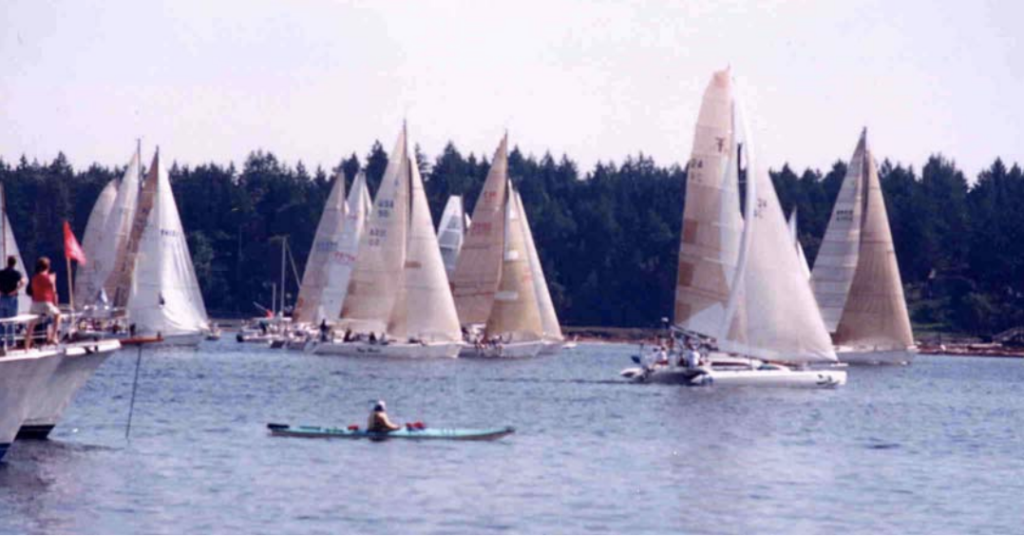
Well that great north westerly wind that slowed down the delivery trip from Sandy Point to Nanaimo on Thursday, the one that blew out our brand new chute on Friday, you guessed it, was non existent on Saturday. 23 boats lined up on the starting line for the first 22 NM leg to French Creek. It was a close reaching start, 22 boats stacked up at the port end of the line and the Cheekee Monkee is in clear air at the Starboard end of the line. The gun fired at 1030 hours GPS time and off we go in a light breeze. The course is well defined. After rounding Protection Island, keep Vancouver Island to port! As we head north, playing the shore, dodging the kelp beds and threading our way slowly through the reefs to find a favorable back eddy, the wind gets lighter and lighter.
The time limit is 1703 hours. Although we are fighting for the lead with Redshift as we both drift about in the Straight of Georgia, by 1600 it is clear that we aren’t going to finish the first leg within the time limit. Already, boats from the back of the pack are motoring towards us. It is time to call it quits. What a let down, the first leg is abandoned by all of us. We can’t get to the finish line in time. In 6 hours we only managed to cover 18 NM, that’s
an average of only 3 knots per hour.
The Skippers meeting is at 1800 and I miss it as we are in the middle of a fabulous dinner. The race management takes exception to my absence, gosh, that won’t happen again. There is a great bar at French Creek, lots of fun to be had that night. For those who booked rooms at the Inn, soft warm beds and a hot shower as well.
French Creek to Comox – June 4
Start: 0900 hrs. The start is off the French Creek Marina breakwater. Excellent spectator viewing from the breakwater.
Finish: As the tides are very low at the Comox Bar the finish will be a line extending across the bar allowing boats to finish on either side of the bar. Preparations are under way for an informal “Mount Gay Rum” dash from the finish to an unofficial finish off the public wharf in Comox Harbor. Excellent viewing from the waterfront and Edgewater Pub.

Let it blow, let it blow, let it blow! The entire fleet was silently praying last night for good strong winds for today. We didn’t quite get strong winds, but we had some wind and that makes all the difference in a sailboat race.
We covered Redshift, an ultra light F-9A and last year’s winner of the race. It was neck and neck all the way from the Island over to the west coast of Texada and back again. We sat on top of Redshift on Port tack. We waited patiently for them to tack. But no way, Wayne’s decided we would keep sailing until there was no more water. If anyone was going to tack first it would have to be the Cheekee Monkee. About the time that we could see the whites of the eyes of the squirrels sitting in the branches of the trees on shore, Wayne finally decides it’s time to go and about we go.
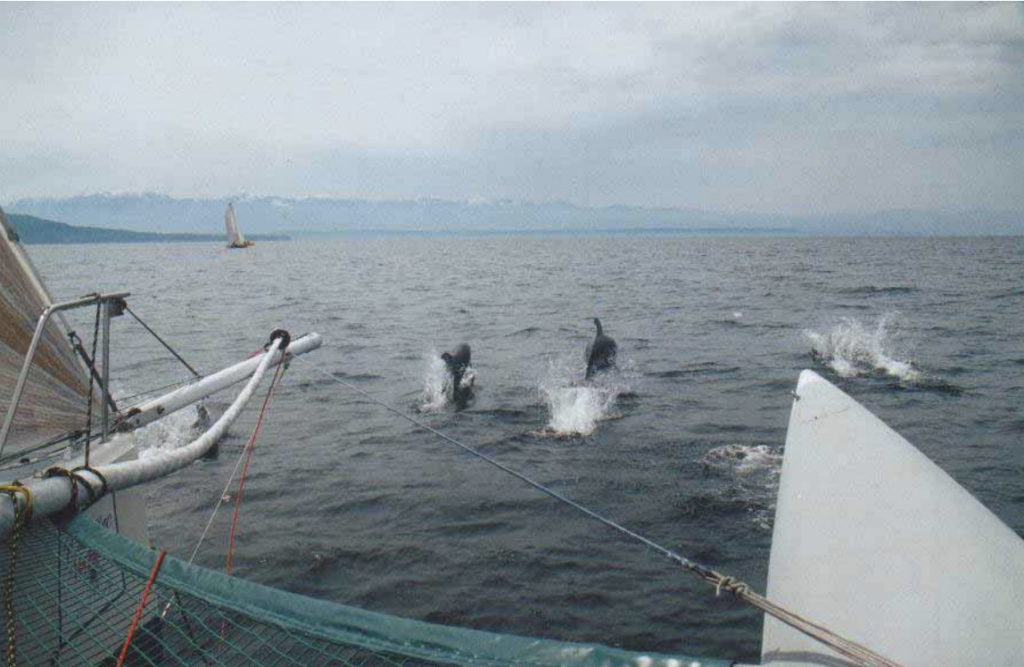
It seems that we just can’t hang onto Redshift in the lighter winds even when the dolphins try to lend a hand. Sailing over to Texada Island didn’t help either of us out as several of the mono hulls found stronger winds on the west side of the straight and beat us to the finish line. The wind eased up as we got closer and closer to the finish line. Diehler was first boat home; they beat us in by an hour and 15 minutes. We finally get across the line and then it is a drifting drag race across the bar into Comox for the famous bottle of Mount Gay rum! We made it in and won our bottle.
As a non-drinker, I became quite popular on the dock later as I spread the wealth around. Based on today’s result, (7th boat home), trying to get our competitors drunk before the next days leg seemed like a good plan.
Comox to Campbell River – June 5
Start: 0800 hrs. The start is outside the Comox Bar. The water is a little thin through herebut should not present a problem.
This leg has been voted one of the most likely to not be completed. As you know this is where the tide splits. The tide floods south north of Middlenatch Island and north, south of Middlenatch. No matter how it is planned, there is no break from the tide and early in the afternoon the tide is strong against us approaching Campbell River.
Finish: The finish will be near the P60 buoy at Wilbey Shoals south of Cape Mudge. There should be favorable current here providing the approach is from the right direction. Eddies can be found close to the shore on the southwestern shore of Quadra Island.
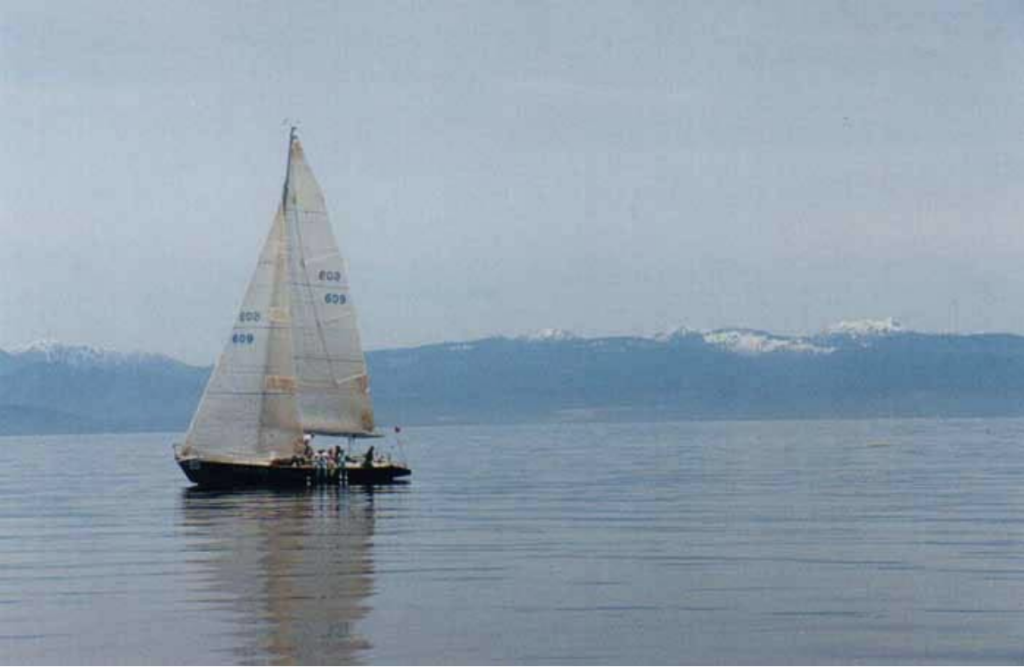
Light airs plague us at the start. Fog, rain, current and an on again off again wind followed the drifting start outside the bar at Comox. There was current at the start line, trying to carry the fleet over early. We held back for a port tack start, we got the screecher out and ghosted across the line. Chasing the cats paws was the opening strategy as the fleet worked
to the North East to round Cape Lazo to port. The Cheekee Monkee and 3D chose to work along the easterly shore of Vancouver Island. It seemed the rest of the fleet took off to the east and out into the fog in search of wind.
The further north we sailed the more the wind filled in. After several hours we were charging along at 7-9 knots with the spinnaker up. We slowly pulled away from 3D and completely lost sight of every other boat in the fleet. The finish line came into sight with the only boat that we could see was 3D. They were about 20 minutes behind us. As required, we called the race committee and they notified us that they were not on station and that we would have to take our own finish times as we were going to beat the race committee to the
finish line. It looked like we had first place all locked up. The crew was getting very excited.
Then, (Dah Dah, Dah Dah, theme from Jaws) out of the fog over to the east, a glint of yellow sailed into sight. We were heading for the finish line on Starboard Tack; Red Shift was coming in from the far side on Port Tack. As we closed on the finish line, Red Shift nipped us 1 minute 4 seconds. That was pretty amazing sailing. We both went in completely opposite direction and arrived at the finish line after 24 nautical miles only a minute apart.
On the last leg, they took us by 1 minute and 48 seconds. Well at least we reduced the gap by 40% in elapsed time. Wait a minute! The last leg was 31 nautical miles, 29% longer than this leg. So we only improved by 23%, not so good.
We were very lucky to arrive at close to slack water so the trip up into Campbell River was anti climatic. However, looking out later we could see the current ripping past Campbell River at 8 – 10 knots. The next few legs would have lots more challenges for us as we work our way north sailing though narrows and high walled passages.

Campbell River to Hardwicke Island – June 6
Start: For obvious reasons the fleet will power through Seymour Narrows to start in Deepwater Bay 12 miles north of Campbell River and boats will need to leave the docks early to make the 0900 start. Seymour Narrows is the main shipping channel for all traffic (cruise ships, log booms, you name it) heading to or coming from the North. The currents through here can get up to 16 knots.
Finish off Eden Point in Chancellor Channel. Northwest winds are common at this time of the year and can be very brisk. The current could prove challenging near the finish line if arriving late in the day.
Well this leg turned out to be the worst leg for the Cheekee Monkee. It seemed that we had our own personal no wind zone. We chased and chased and chased that no wind zone all the way to Chatham Point. We were so effective at being in that zone, that we were battling Onnetar for the last to finish spot. As it was, we narrowly beat them across the finish line by 34 seconds to lock down a 22nd place finish and they were gaining on us at that point.

Back to the beginning, after motoring through the dreaded Seymour Narrows we got set up for the Start. It was clear this leg was going to be a light wind leg. Drifting conditions and the occasional zephyr danced over the waters at the starting line. We set up for a good start, and got shut out by a couple of monohulls at the line. We ducked around, popped the chute and got off to a reasonable start (well not really) and we worked our way down the starboard side of the course to the front and promptly sailed into a hole. By this time, Redshift was on the other side of the channel where the wind was starting to fill in nicely.
We gybe over and head for that side, by the time we get there, Redshift has taken the wind with her. That is pretty much how the first leg played out until we started closing on Chatham Point. By that time, three quarters of the fleet was in front of us. There was quite a current flowing north and west with us by this time, as we get to the point the wind vanishes. As we had be hugging the shore playing the wind as we slowly worked our way up to the point, this set us up for an exciting rounding. As we approached the Reef marker on the point, we witnessed Hobbes rounding the corner sailing backwards at 2 – 3 knots in the grip of the current just a few yards outside of the reef marker. The closer we got to the marker the clearer it became that we would not be able to sail around it. No wind and a current running at 90 degrees to our heading. We can’t clear the point, the current inside
the reef marker between two ominous looking reefs sweeps us though as I give the command to raise the dagger board, and I quickly raise the rudder. With boat hooks at the ready, we round the point traveling sideways at 2 –3 knots right through the middle of the kelp bed. Hell if it was deep enough for kelp, it is deep enough for the Cheekee Monkee; we only draw 18” with the boards up.
Boards back down; we are now heading west in Johnstone Straight with the current pushing us towards our destination. The wind starts to fill in from the aft starboard quarter; it is time to get the chute back up. The wind is rising and we are now quickly passing other boats as we are making 15 – 16 knots through the water and an astounding 20+ knots over the bottom. The grins are pasted on our faces as we charge down the straight. The sliver lining before the disaster!
We are flying along and then SNAP; RIP, TEARING Noises and the spinnaker heads for the drink. Quickly (well actually this took a bit of time as 2 or 3 of those mono’s that we had gone screaming by asked if we required assistance as they went screaming by us, that should teach us a little humility) we recover what is left of the spinnaker from the water and then look up. The only thing left flying is the head of the spinnaker along with the luff and leech tapes. The head had ripped right off the spinnaker.
I didn’t understand why it blew out, it was flat water, we have sailed faster with that chute and in rougher conditions. The only thing I can think of that might have caused this failure was that we sailed into a back eddy at 15 knots and lost the 5 knot current push in the blink of an eye. This instantly loaded up the chute and blew it apart. Chalk up a new experience.
After stowing the dripping remnants of the sail, we raised and unfurled the Screecher and set out to catch some more boats as we now had a solid lock on last place. If this story is starting to sound like the story of the tortoise and the hare, keep on reading, the similarities are startling. The wind started to ease up, rain showers came and went, by the time we got to the finish line, and well I already told you our finish position.
We motored from the finish line to the salmon pens for the night’s moorage. This turned out to be the only really wet night that we had during the two weeks of the race. A salmon barbeque, courtesy of West Coast Salmon Farms on the deck of a huge landing barge under the bright orange glow of the rain tarps made a fitting ending to a very frustrating day for the crew of the Cheekee Monkee.
Hardwicke Island to Telegraph Cove – June 7
Start: 0800 hrs. In the vicinity of the finish area. In the wider parts of Johnstone Strait, the velocities of tidal streams may vary from 1 to 4 knots; in narrower sections rates up to six knots can be expected with heavy rip tides in some places.
Finish: is between the entrance to Telegraph Cove and Lewis Point. Excellent spectator viewing
It’s a clear morning, not yet sunny, but looks promising for the race up to Telegraph Cove.
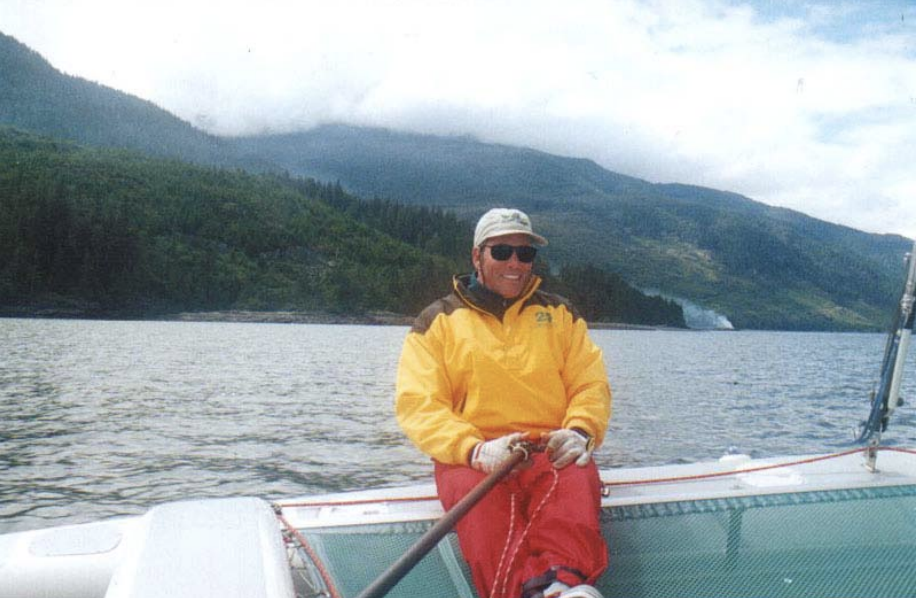
Winds are light for the start with a following current; we experience a general recall for the first start. For the re-start, we are jockeying at the shore for the favored end of the line, this time many hang back not wanting another general recall and the race is off. This leg is upwind, thank goodness, as we don’t have a spare spinnaker. We did manage to ship
ours off with a crew person heading back to Nanaimo. Hopefully, it will be repaired and back to us by the time we reach Port Hardy. Just in case, Carl Utoff, of Tardis, (now known as Bad Kitty) lent us his heavy weather spinnaker.
We still must have been suffering from the trauma of the day before; we could not get ahead of Redshift and finished this leg after 7 ½ hours in 6th spot. Persuasion was first boat home, almost 7 minutes ahead of Diehler, they did a great job! Redshift was 3 minutes and 24 seconds ahead of us on this leg. Seems our performance has swung back the wrong way.
Telegraph Cove to Port Hardy – June 8
Start: 0800 hrs. The start will be the same as the previous finish. Currents in this area can make sailing very interesting and navigation is tricky. This is still whale country so keep your eyes peeled.
Finish: The finish in Port Hardy is between the government dock in town and a gray fish processing plant on the point directly opposite. Excellent spectator viewing.
Now this is the kind of picture that we like to see. This is the finish line in Port Hardy. We finally finish ahead of Redshift. We beat them across the line by 50 seconds. Not enough to beat Redshift on corrected time, but we did get across the line ahead of them. Unfortunately, it wasn’t a first to finish leg for us as Diehler, sailed masterfully, had chewed up the ground and come in 27 minutes and 14 seconds ahead of the Cheekee Monkee.
You can see us flying the heavy weather spinnaker we borrowed from Tardis. Thank you Carl, it helped us hold off Redshift at the end of the race.

From the start, until we rounded Dillon Point, it was upwind with a freshening breeze. With the wind up a little more, we became more competitive. After rounding Dillon Point, it was downwind to the finish line with Redshift gaining on us after every gybe.
I haven’t commented much about the shore side activities in each port, but let me tell you, they have been fantastic. Port Hardy put on a great barbeque and an entertainment event for all the Van Isle racers. Like Campbell River, they pulled out all the stops to make us feel welcome. This aspect of the race has been very heartwarming.
After dinner and the entertainment, I checked in with the Greyhound office and was able to pick up the spinnaker. It had been repaired down in Nanaimo, put on the bus and sent back up to us. Great work with an excellent turnaround. We hope it holds together for the rest of the race!
Port Hardy to Winter Harbor – June 9
Start: 0800 hrs. Same as the previous finish.
This leg is where things can get very interesting. The boats will leave with the current in their favor and with wind could reach Nawhitti Bar before the current turns. The bar has a reputation for being one of the nastiest bits of water on the coast but it can also be benign. Depending on weather it could be a good shortcut. This leg could be one of the most challenging in the race. Finish: The race committee will be on station at the Kains Island lighthouse and the finish will be a transit from the lighthouse to Robson Rock 0.62NM. and bearing 081 magnetic from the lighthouse. This is the preferred entrance to Forward Inlet from the North.
Light winds at the start, it is a reach up to the corner at Duval Point where we hang a left a head northwest up Goletas Channel. Buoyed by yesterday’s excellent finish, we get a very good start and are the first boat to Duval Point. The fleet is hot on our heels as we round the point with the spinnaker up and take off down the channel in a freshening breeze. The wind is building and we take off, 15+ knots tacking back and forth down wind from one side of the channel to the other. The fleet spreads out a riot of colors as we leave them in our wake. Our speed is now pushing 20+ knots, we have flat seas and the Cheekee Monkee is doing a horizon job on the rest of the fleet. As we approach Nawhitti Bar, we are all alone in first place; we can’t see any of the boats behind us. We have been given the satellite phone
for a radio interview. The radio station calls and Andrew, our Aussie mate handles the interview as we charge out of the straight, across the bar at 16 – 18 knots.
As we head out into the open ocean of Queen Charlotte Sound, the seas are beginning to build. The Cheekee Monkee is flying off the tops of the waves and crashing into the troughs. This lasts about 10 minutes as the wind is starting to swing to the West. RIIIIP, SPLASH, STOOOOPP, there goes the repair to the spinnaker! We quickly recover the chute
and get the screecher unfurled and flying. The wind and seas are building. Tardis and Redshift have made up a lot of ground during the past few minutes as we fumbled with our sails. We head out to sea; we want to give Cape Scott a wide berth. The seas build, the wind increases, and Andrew becomes incapacitated with seasickness from the violent action of the cross seas. We manage to furl the screecher and get it down on the deck. Up goes the small jib. It is not enough of a sail reduction. We are still overpowered as the wind swings west and builds in strength. We get a reef in the main and are pounding along at 10 –12 knots off the tops of very nasty steep and short waves. Andrew laying on the net and has his head over the side and can’t move.
It hasn’t been but a few minutes as we pounded along, making our way out into the straight. We can see Tardis and Redshift staying closer to the shore. The rest of the fleet is approaching the bar now. We are well off and making good time. The wind is 30 plus with seas at 6 – 8 feet, very steep. Without any warning, the mainsail comes crashing down on the deck. Something is wrong with the halyard, it looks like the main halyard has broken. The
topping lift released as well and the main and boom are now hanging over the lee net. My other crew is starting to get concerned about our situation and Andrew is still out of commission with seasickness. As we are not far from Cape Scott and we need to find some relief from these seas and wind to effect repairs, we head northwest over to Cox Island. I am sure we can drop anchor in the lee side, straighten out the boat and get going again. I have a spare halyard on board and am not concerned about getting going again if we can get into some protected waters so I can go up the mast if I need to. Sailing slowly under jib alone, we arrive at Cox Island. I spot a small cove on the North East corner of the island. As we go in one of the crew becomes very nervous about anchoring so close to the rock face in
this little cove. The charts indicate we should be fine; we are in the lee and have a good holding in about 30’ of water. As soon as the hook is down, Andrew feels much better.
We take the time to get cleaned up, dry clothes and have some hot food before tackling the repairs. We have straightened up the sails and rigging. I now start looking at the problem. I can’t figure out why both the topping lift and the halyard let go? The topping lift is bolted to the top of the mast. We let go of the main halyard, expecting it to be piled up inside the mast but no! Somehow the end of the main halyard and the topping lift are connected to each other. Having let go the main halyard, by pulling on the topping lift, we are able to recover the main halyard. Wow, that was easy! We didn’t have to go up the mast after all!
I connect up the new 1:1 halyard and pull out the failed 2:1 halyard and discover what happened. The fixed end of the 2:1 main halyard and the topping lift were bolted to the carbon fiber at the top of the mast. The bolt and eye strap along with the ends of the main halyard and the topping lift ripped out of the top of the mast while we were reefed and pounding in those steep seas. With the new 1:1 halyard run, we set a double reef in the main and raised the small jib. Battened down the hatches, raised the anchor and set out to sea once again. As we were in the lee of Cox Island, there was hardly any wind. As we creep out around the corner, the crew piped up with the suggestion that maybe the wind had dropped. I said, no way, it had just swung around some more, and any moment, we would be back in the BIG WIND. We round the next corner, still no wind, finally, we are leaving the Island astern, still no wind (5-6 knots) we are going real slowly with the small jib and the double-reefed main. We can see the last place yacht rounding Cape Scott about 6 miles ahead of us. It is Endangered Species. Well, obviously the wind had dropped while we were hiding out behind Cox Island. The seas were still big, but the wind was very light. We shake out the two reefs and then get ready to raise the screecher off the deck. The Screecher gets about 2/3rds of the way up and the 2:1 halyard is totally twisted, we can’t get it up (it’s not what you are thinking). We try repeatedly without any success. Finally, we give up, drop the sail and switch over to the spinnaker halyard. We can’t get any luff tension with the spinnaker halyard so the sail is not working effectively. I decide to redo the Screecher halyard while we work our way down the coast to Winter Harbor. One of the crew works the satellite phone to see if we can borrow a couple of F-31R spinnakers for the rest of the race. We are in luck! We manage to get 2 spinnakers on their way to our house in Bellingham, WA from San Diego; CA. Lynda will be standing by to drive the Spinnakers up to Vancouver Airport when they arrive the next day. We can see less wind inshore and more wind out where we are. We stay about 10 miles off shore and head down the coast. Slowly, slowly, we are starting to pass those boats that are hard on the shore. From about last spot by 5 – 6 miles, we reel in the competition one by one. We gave up about two hours with our little side
trip to Cox Island. One after another, we reel them in until the finish line is in sight. Slowly, slowly, we work our way into the mouth of Quatsino Sound. There is the line; so far, we have passed 15 other vessels on our 30-mile jaunt down the west coast of the Island. We finish in 5th spot, 1 hour, 10 minutes and 25 seconds behind the first place finisher, Redshift. What a disaster, what a comeback.
Well not enough of a comeback, as we placed last in the multi-hull fleet for this leg. 3D placed first! Way to go Dave!!!
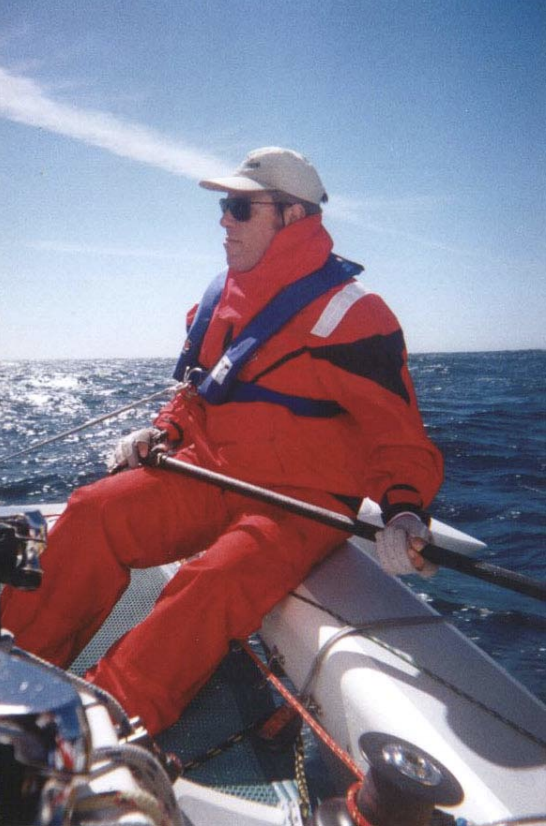
Winter Harbor to Ucluelet – June 11
Start: 0800 hrs – across the previous day’s finish line. At 141 nautical miles, this is the longest leg of the race. Many will opt for a longish offshore leg to avoid the turbulent
waters off Brooks Peninsula locally called the “Cape Horn of the West Coast”. This time of the year there is a good chance for favorable winds but it’s anybody’s guess.
Finish: The race committee will be on station at the Amphitrite Point lighthouse. The finish will be a line from the lighthouse to the Red whistle buoy Y42. Excellent spectator viewing from Amphitrite Point. Depending on conditions some boats may finish in daylight hours. It is more likely that this will be a night finish and the entrance to Ucluelet can be challenging
especially the first time. Escort boats and Coast Guard Auxiliary will be on hand if finishing at night. This will be weather dependent and all racers should exercise extreme caution in this area.
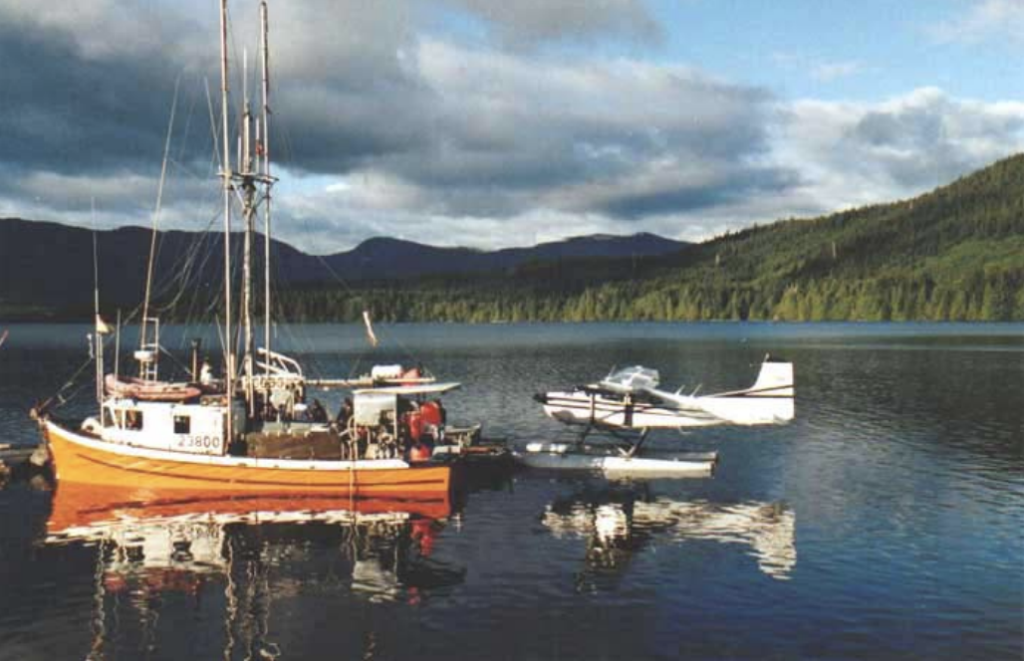
This is the seaplane that we chartered to fly down to Vancouver to pick up the two borrowed spinnakers. I was fortunate that there was a crew person that wanted to split the cost with me so he could get to Vancouver quickly and could then fly on home from the Vancouver Airport. We were in touch with Lynda from hour to hour, had the sails arrived yet?? We were running out of time. Finally, she gets a call from a neighbour up the street. UPS has delivered our sails to his house, would she like to come and get them? When it absolutely has to get there, use Fedex! At last, she is on here way to Vancouver with the two borrowed sails, we call the plane and it comes in, picks up our twice ripped spinnaker and the crew for Vancouver and heads out to meet Lynda at the Seaplane terminal at Vancouver Airport.
The Plane, The Plane, there it is flying in before the sun sets with our two borrowed spinnakers. We are now ready for the next leg and the challenge of BROOKS Peninsula. The morning dawns cloudy, there is wind. We check with some other crews. Someone has an Internet download of the weather chart. There is a low pressure developing south of us.
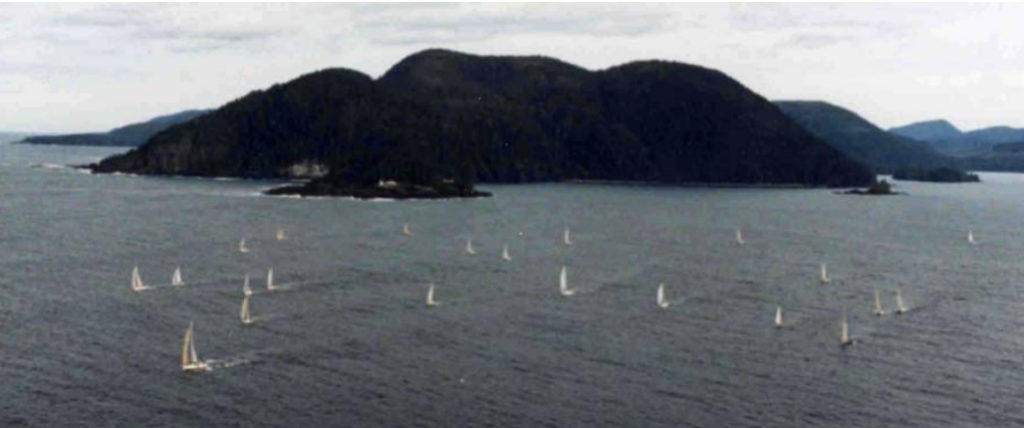
The race committee says the race is on. As we head out, we hear Coast Guard warnings that the storm forecast has been upgraded to a full storm warning. They suggest that all vessels return to port. We continue. We have set a waypoint for a layline about 30 miles offshore, about 15 miles due west of Brooks peninsula. Before the start, we rig the small jib and a single reef in the main. Andrew has been taking seasickness medicine for two days now, hopefully, that will take care of his problem. We start the race, the wind is fluky, seas are still small, we are under canvassed. We shake the reef and set the screecher. Of we go, charging out into the awaiting storm. The wind slowly builds and we finally furl the screecher and drop in on deck. We have the big jib up and full main. We are heading SSE at 12 – 14 knots. The wind and sea builds, we go to the first reef. Then we switch to the smaller jib. Still holding 12+ knots to windward. The wind continues to build. A double reef in the main. The seas are starting to get very large. The fleet is well behind us. We pass our waypoint. In these conditions, I am thinking we are experiencing a convergence off Brooks so, I think if we just keep going, and it will ease up. It doesn’t, it just gets worse. The wind is blowing the tops off the waves. We are sailing on one hull most of the time. I am grinning from ear to ear, we are flying. The wind still builds. Time to drop the jib. We are now making 10 knots to windward under double-reefed main only. Next step bare poles. The seas are so steep that there are now breaking over the windward Ama. The wind must be approaching 50 knots; the seas are being flat-topped by the wind. I can’t stay in my seat on the windward Ama and I can’t see. The wind is filling the air with a spray that hits your exposed skin like hailstones. I can’t see and I can’t stay in my seat. We have never been in weather this heavy. I am not looking forward to 24 hours of this stuff. It’s time to pull the plug.
The crew calls in to advise both the Coast Guard and the Race Committee that we are withdrawing from the race. The crew is cowering in the cockpit as waves break over their heads. We carefully pick our spot and execute a tack to windward and come about onto Starboard tack. We forget to let go the mast rotator and the lower spreader pokes a significant hole in the mainsail as we go about. It’s a fast ride back into to Winter Harbor, more boats start to follow our lead and also drop out of the race. After awhile, closer to shore, the wind is under 35 knots, I start to feel sheepish about bailing out, I ask the crew, was it really that bad out there? They say yes it was!
On our way back in we hear that Tsunami was dismasted and Ballenas stands by to help them out. Back at the dock, we hear that Mad Max is continuing on, Diehler is putting in down the coast, 3D is heading north, and we are not sure where they are going. Most of the rest of he fleet comes back into Winter Harbor for the night.
The next day we set out to sail on a delivery trip down to Ucluelet. Surely, nothing could go wrong. We still had the big seas, but the wind was gone. In 20-20 hindsight, we should have taken a lay day yesterday and raced down today. Sailing most of the time, we would hit the occasional doldrums and fire up the motor for a half hour or so. Later that night, I am trying to snooze below decks and the crew fires up the motor again to get us through
another light patch. The motor is getting too much air in these rough cross-seas the motor complains vigorously and then dies with a whimper. Now we have to sail all the way there. Another low is forecast to come in from the south. In the morning, I think we will arrive at the starboard layline about the same time the front does. Its pretty close as we head in to the finish area at dawn with a building wind. We manage to get a tow into the dock from the Coast Guard Auxiliary. The tally for this leg, one brand new 8hp Honda and a hole in our high tech Kevlar mainsail.
Ucluelet to Victoria – June 14
Start: 1000 hours. The start line is in the vicinity of the previous day’s finish. Excellent spectator viewing from Ogden Point and Dallas Road.
Finish: The finish will be similar to the “Swiftsure” harbor finish inside the breakwater in Victoria.
We all get a lay day in Ucluelet. The race committee is concerned that all the competitors will not arrive in time for the start if we don’t take a lay day. That’s too bad because the wind is blowing today. It would be a fast ride to Victoria today. Yesterday, for $2,500.00 CDN, I was able to purchase another brand new 8hp Honda outboard motor for the Cheekee Monkee. After swapping over the control handle and the prop, we were back in business.
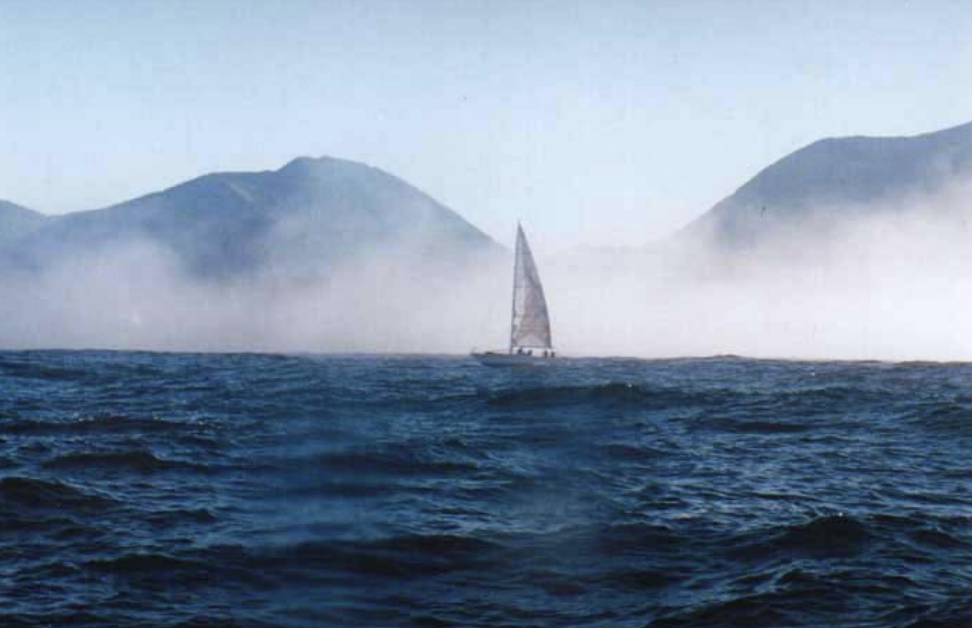
The morning dawns clear, the wind has let up and we head out to the start line. Good thing for GPS and chart plotters. The fog is so thick you can hardly see the water. It is patchy at the line and the gun goes off and we start off drifting across the line. We work our way down the coast in light airs. Once again we are out in front. Tardis, further back in the pack heads out to sea. We can see that they are heading for a wind line. We head out, so does most of the rest of the fleet. Tardis gets there first and takes off like a shot. Redshift is next into the wind. Finally we get the breeze and set the chute and start chasing the other multi-hulls. The wind builds until it is blowing a solid 30+ offshore and a little les than 20 inshore. We tack out and take off chasing down Redshift. Tardis after building a giant lead heads for the shore. We head down for Cape Flattery where the wind seems to be stronger. Redshift is chasing us for a change.
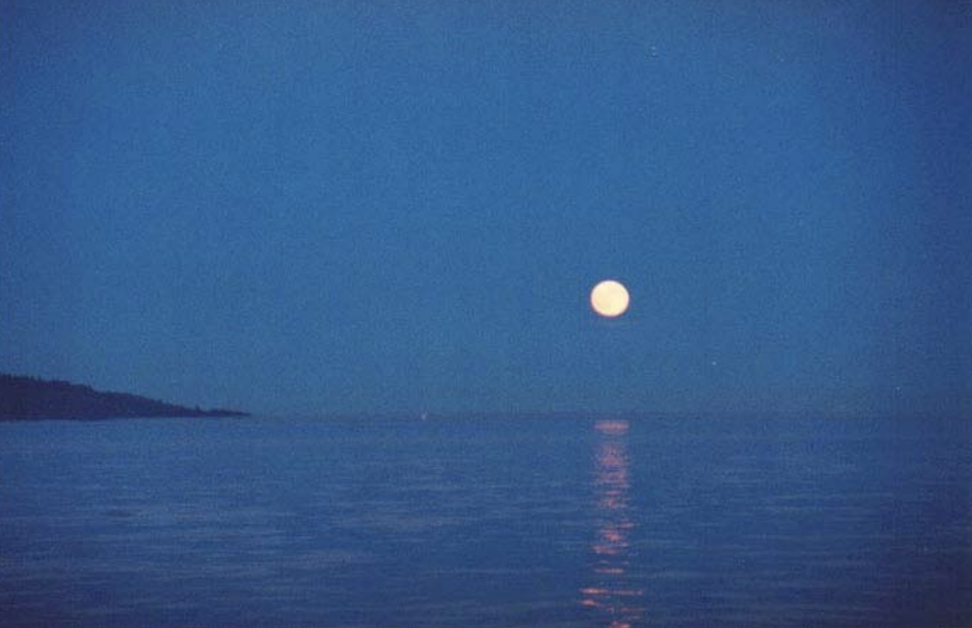
We enter the strait on the US side and head down the shore. The further in we go and the later it gets, the lighter the wind blows. Finally it starts to just shut off, it might even be sucking instead of blowing. In these conditions, we head over for the Canadian side; we don’t want to be stuck out there in deep water with the tide running out. Redshift stays in the middle and we leave them behind.
Diehler claws past us in the dark hours of the very early morning. They are able to get some motion going along the beach as we just seem to flop around. Finally, it looks like there is more wind in the middle, Redshift has sailed into the beach by now and we head out into the middle. We find some breeze and start making progress down the straight. By the time the
sun comes up, we are well ahead of Redshift but having to chase down Diehler who made solid gains along the shore. We pass Beachy Head; Diehler is heading to pass inside of Race Rocks. The current is against them, we watch carefully, will they get through? We stay nice and wide; we know there is no way we can beat the 6-knot current. We sail outside the race and we watch Diehler sit there as we sail right on by. We charge in towards Victoria and the finish line.
Of course the closer we get to the finish, the lighter the wind is. We finally hit the line after 25 hours and 30 minutes IN FIRST PLACE at about 10 in the morning. First boat home, first in class, finally a decent performance. The next start is at 5PM today, no rest for the wicked.
Victoria to Nanaimo – June 16
Start – 1700 hrs. The start will be off Brotchie Ledge. Excellent spectator viewing from the shore. This leg is started in the evening to give boats the best opportunity of finishing in daylight hours in Nanaimo.
With so many routes to Nanaimo this night sailed leg will no doubt have most navigators pulling their hair out. Significant differences in the length of these routes and tides through the many passes will prove challenging.
Finish: The finish will be off the end of the Visiting Vessels Pier in Nanaimo Harbor.Excellent Spectator viewing.
After lunch and a two-hour nap, we are back out on the water ready to take on the next and final leg. It’s a pretty day, but no wind at the start. It’s a drifting race to Trial Islands. Then the wind fills in from the west and up go the spinnakers. We have a breeze from Trial Islands through the pass at Discovery Island. It’s a good thing because we are fighting a 3- knot opposing current at that point.

After starting up Haro Straight, it looked like the fleet was going to split. We elected to cover Redshift who seemed to be heading up the inside over towards Sidney, looked like Diehler was going to go that way too. The rest of the fleet lead by Tardis and Mad Max headed up Haro Straight. The sun went down and the wind shut off. We dropped anchor near Redshift and Diehler and waited for the morning and some wind. The first boat moving
is Diehler, then Redshift; we finally join the parade even though there is not much wind. We still have an opposing current. We discovered that it’s hard to go where your competition is planning on going when you don’t know where there are going, especially when you are in front of them. Redshift managed to park us in a few wind holes as we tried to decipher his intentions. Finally we had it figured out and up through Sampson narrows we went trading places all along the way.
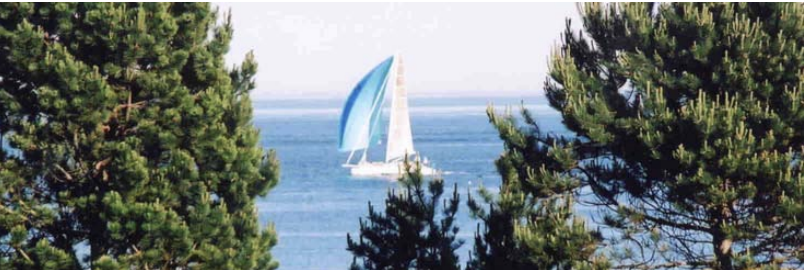
We were headed for Dodds Narrows, could we get there in time? Or should we try for Gabriola Passage, which was slightly closer? We were well ahead of Redshift and Diehler. We arrived in Dodds about an hour too late. We ghosted up in the back eddies to within 4 boat lengths of the far end of the passage but we couldn’t go any further. We moored to the rocks with our mast and sails in the trees and waited and waited.
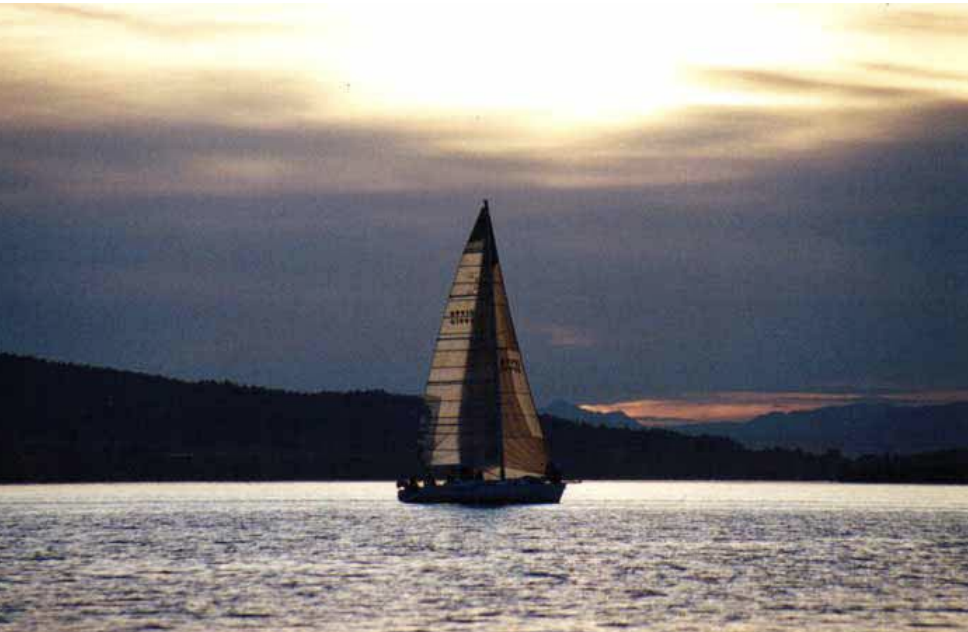
Diehler showed up several hours later and now there were two sailboats in the narrows. The wind piped up and the current eased so we tried to sail through once again. Making only inches of progress on each tack. Too close to the port shore on one tack and the dagger board hit a ledge. We need to go in there to get a run at the current so this is a problem. Everyone is dead tired. We have been up racing for three days. We back off and wait again.
We hear over the radio that Tardis is first boat in. This news seems to precipitate a crew melt down on the Cheekee Monkee, it’s been too long, and we are too tired. After a vigorous confrontation with one member of the crew, I decide that we are going to start the motor and leave Dodds Narrows to Diehler; there is not enough space for the two of us.
It was extremely disappointing to have to abandon the last leg only 7 miles form the finish line. On our way into the harbor we pass a 26’ powerboat that seemed to be in trouble. We offer assistance and they decline so we proceed. Moments later, they are firing off flares and back we go to take them undertow. After seeing the flares, the race committee is now on the way out and so is the Coast Guard. We turn the tow over to the Race Committee and head into the dock. It’s well after midnight; we are tired and worn out. Our arrival at the dock is anti-climatic for us.
This has been the best regatta that the Cheekee Monkee has ever been in. We have had disappointing setbacks from both the equipment and the crew. It’s tough but we have unfinished business. Next year we will be in better shape and we will finish all the legs.
Now didn’t this seem a little bit like the story of the tortoise and the hare?
Link to original article (click here).